ETegro Hyperion RS430 G4 - ready for Big Data
In addition to the ubiquitous "clouds", one of the most popular and discussed topics in the server world is now the concept of working with Big Data - very large volumes of semi-structured data of the most diverse types. We will not deal with issues of software data processing, but show the platform on which, in our opinion, this is worth doing: our new ETegro Hyperion RS430 G4 server.
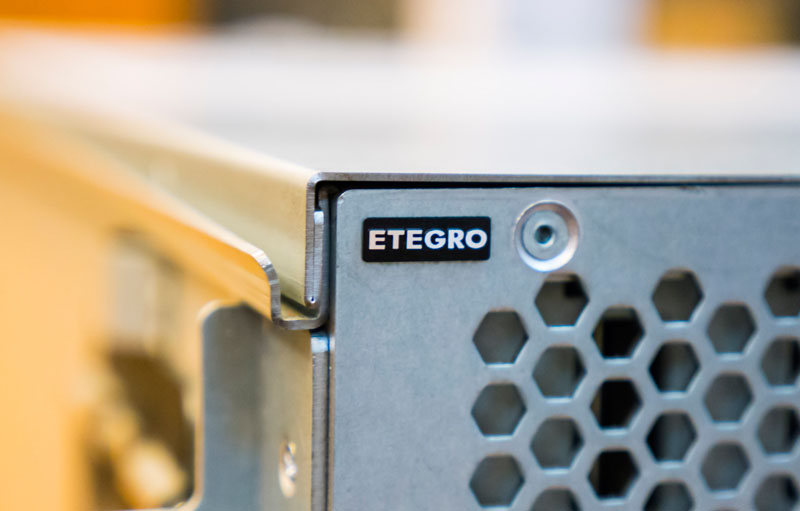
')
So, what do you need to work with Big Data? Of course, disk space, a lot of disk space, with a high degree of availability from a fairly powerful computing platform. Well, as always, it is highly desirable that this can be easily preconfigured, convenient to maintain and at the same time use up as little as possible in most cases of rack space.
To implement all this, we suggest using a 4U server. Inside it, thanks to the super-dense layout, we managed to place 70 3.5-inch disks and two separate platforms with motherboards, each of which has access to 35 disks and is additionally equipped with two dedicated 2.5-inch disks that are suitable for the operating system system. Naturally, all drives are hot swappable.
Next we will have a certain number of numbers and characteristics that are easier to perceive as a list.
Two motherboards, each of which has the following features:
For the power of the entire system are responsible four power supply units, with a capacity of 1200 W each, certified according to the standard 80+ Platinum. The modules support hot swap and are duplicated according to the 2 + 2 scheme.
But enough text, let's now look at this beauty.

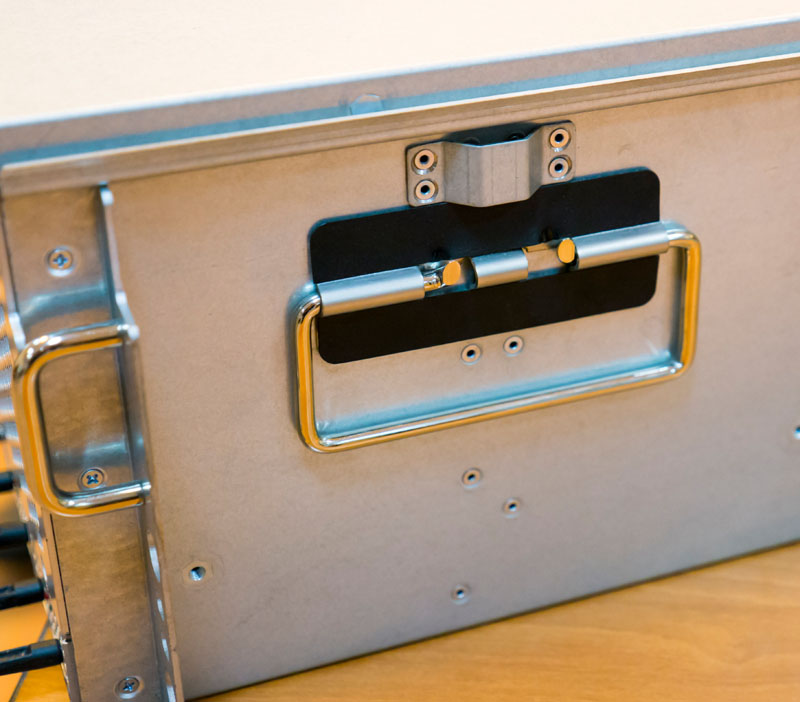
The first thing that comes to mind when looking at this monster is an old joke about the fact that Soviet processors have 48 legs and two carrying handles. True, the RS430 G4 handles as many as four and their appearance inspires respect for its thoroughness. However, why do you need them very quickly you understand, as soon as you need to move the server - in full “stuffing” it weighs about 115 kilograms, so you can’t take it by the edges of the case.


Approximately three-quarters of the top panel is occupied by an impressive cover covering access to numerous hard drives. On it there is a rather impressive, but still a brief description of what, where and how is located in the server, designed to somewhat alleviate the fate of the system administrator.


The rhythm of the photo is fascinating, isn't it? The 14 rows of 5 drives in each are equally divided between the two motherboards. And somehow you automatically begin to multiply 70 by 4 TB, which is today the maximum amount of a modern hard drive, and the resulting number, exceeding a quarter of a petabyte, makes you wonder ...
The hard drives, which are located in even slender rows, are placed in a fairly simple sled for organizing a hot swap. Despite the simplicity, the sled is still made of metal: it’s not about strength, but about ensuring the heat dissipation, which plastic does much worse than with this density.

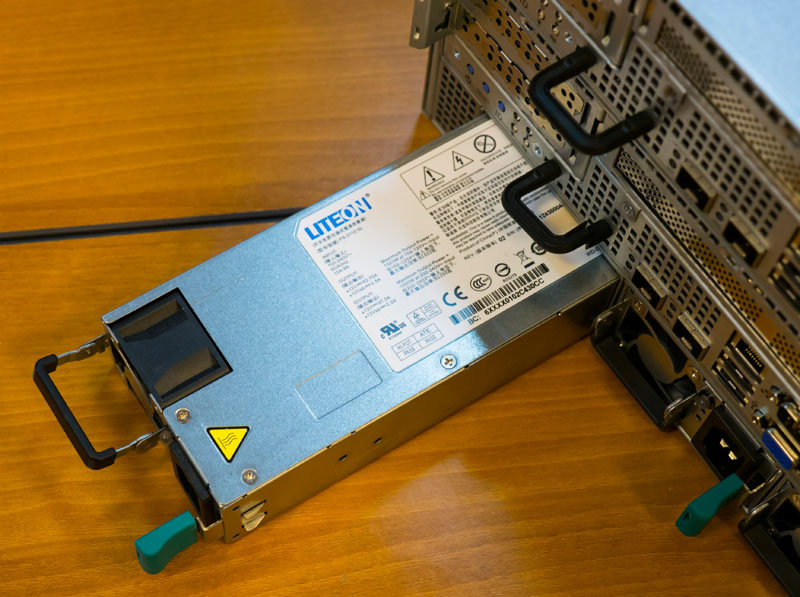
The back panel, as it seems to us, is of no less interest: after all, it can be used to estimate the configuration of the computing part of this server. From above, two sliding platforms are comfortably positioned, each of which is a full-weighted dual-processor server, and the very bottom was occupied by those 4 power supplies with a capacity of 1200 W each. We are ardent supporters of unification, so that the power supply will be familiar to all those who have ever seen a platform with the logo ETegro. Naturally, any module, starting from a hard disk or power supply and ending with each computing platform, can be removed from the server without disassembling it: the maintenance of such equipment simply must be as simple and convenient as possible.

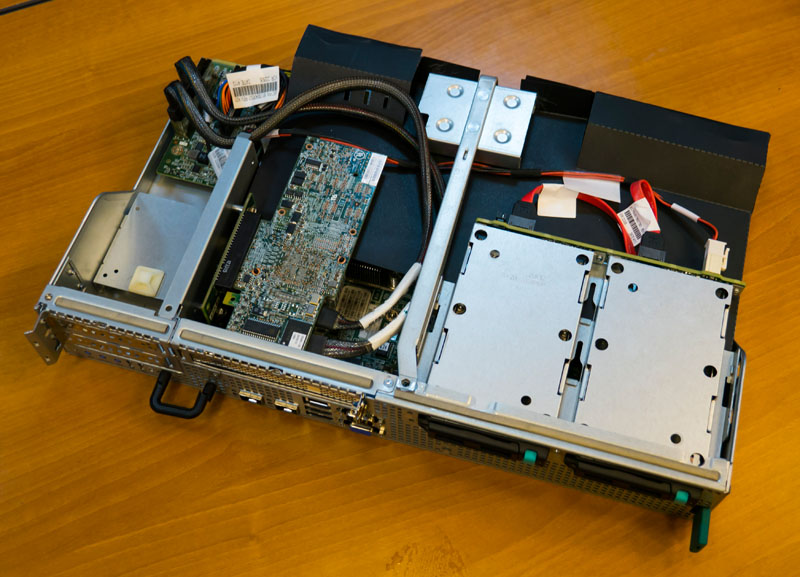
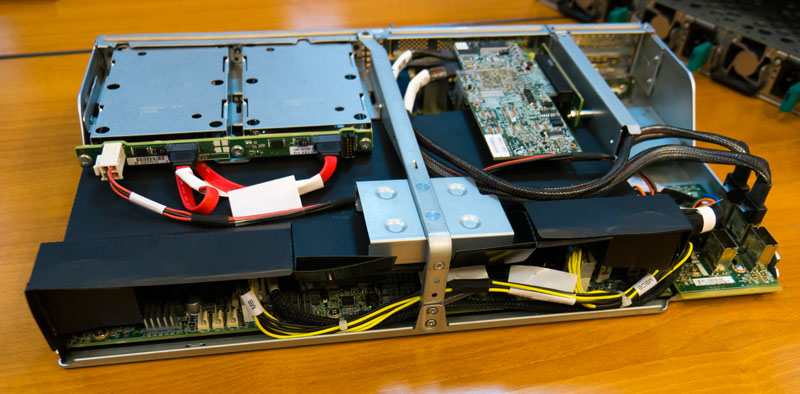
Each module, as mentioned above, is a complete system with its own memory, processors and additional controllers. All this is very tightly packed on a single sliding platform that connects to the disk array with one slot. Another characteristic feature of all our servers are separate footprints for 2.5-inch hard drives or SSDs, on which the OS is so convenient to place, separating it physically from data carriers. In this case, you can see that each server platform has two such footprints: RAID1 is a great thing, you don’t really want such a powerful solution to be idle because one drive fails. Of course, these disks are also located on the slide and support hot swapping - why remove the entire module if this can be avoided?


The back panel of each module reminds once again that each of them is, in fact, a full-fledged server. Here and own full-fledged set of traditional buttons of management, and on two SFP + ports 10G Ethernet, invariable D-SUB, service COM and RJ-45. Well, and of course, the expansion slot plugs, two of which are designed for boards with reduced height, and one for full-size ones.



It remains only to look inside, in the small space between the back, with the board modules and power supply units and the front, with an impressive array of disks. And there is another array, no less important for the functioning of the server. It was here that tightly pressed together 12 powerful fans, diligently pumping air from the front to the back. Fans are noticeably wider than usual. High speed of rotation allows them to create a powerful air flow with strong pressure, which is simply necessary for a server with such a dense layout.
On this, perhaps, all for today. We traditionally do not speak about the cost, because it very much depends on the set of components in the platform, so if you are interested in this question, then you can always go to our website and use the configurator to estimate the cost of exactly that option and with those components that interest you :
www.etegro.ru/configurator/servers/rackmount/performance/rs430g4/buy
As always, we will be happy to answer any questions you may have.

')
So, what do you need to work with Big Data? Of course, disk space, a lot of disk space, with a high degree of availability from a fairly powerful computing platform. Well, as always, it is highly desirable that this can be easily preconfigured, convenient to maintain and at the same time use up as little as possible in most cases of rack space.
To implement all this, we suggest using a 4U server. Inside it, thanks to the super-dense layout, we managed to place 70 3.5-inch disks and two separate platforms with motherboards, each of which has access to 35 disks and is additionally equipped with two dedicated 2.5-inch disks that are suitable for the operating system system. Naturally, all drives are hot swappable.
Next we will have a certain number of numbers and characteristics that are easier to perceive as a list.
Two motherboards, each of which has the following features:
- Intel C602 chipset
- up to two Intel Xeon E5-2600 processors
- Up to 512 GB DDR3-1600 RAM with support for 4-channel operation
- 3 slots PCI-Express x8 version 3.0
- two 10G Ethernet ports with SFP + connectors
- Possibility to install SAS RAID, SAS HBA controllers and 10G Ethernet adapters, FibreChannel, InfiniBand as options
- control and management through integrated IPMI 2.0 and KVM over IP with dedicated Ethernet port
- Support for server operating systems of the Windows Server 2012 family, SuSE Linux Enterprise Server 11 and Red Hat Enterprise Linux 6.
For the power of the entire system are responsible four power supply units, with a capacity of 1200 W each, certified according to the standard 80+ Platinum. The modules support hot swap and are duplicated according to the 2 + 2 scheme.
But enough text, let's now look at this beauty.


The first thing that comes to mind when looking at this monster is an old joke about the fact that Soviet processors have 48 legs and two carrying handles. True, the RS430 G4 handles as many as four and their appearance inspires respect for its thoroughness. However, why do you need them very quickly you understand, as soon as you need to move the server - in full “stuffing” it weighs about 115 kilograms, so you can’t take it by the edges of the case.


Approximately three-quarters of the top panel is occupied by an impressive cover covering access to numerous hard drives. On it there is a rather impressive, but still a brief description of what, where and how is located in the server, designed to somewhat alleviate the fate of the system administrator.


The rhythm of the photo is fascinating, isn't it? The 14 rows of 5 drives in each are equally divided between the two motherboards. And somehow you automatically begin to multiply 70 by 4 TB, which is today the maximum amount of a modern hard drive, and the resulting number, exceeding a quarter of a petabyte, makes you wonder ...
The hard drives, which are located in even slender rows, are placed in a fairly simple sled for organizing a hot swap. Despite the simplicity, the sled is still made of metal: it’s not about strength, but about ensuring the heat dissipation, which plastic does much worse than with this density.


The back panel, as it seems to us, is of no less interest: after all, it can be used to estimate the configuration of the computing part of this server. From above, two sliding platforms are comfortably positioned, each of which is a full-weighted dual-processor server, and the very bottom was occupied by those 4 power supplies with a capacity of 1200 W each. We are ardent supporters of unification, so that the power supply will be familiar to all those who have ever seen a platform with the logo ETegro. Naturally, any module, starting from a hard disk or power supply and ending with each computing platform, can be removed from the server without disassembling it: the maintenance of such equipment simply must be as simple and convenient as possible.



Each module, as mentioned above, is a complete system with its own memory, processors and additional controllers. All this is very tightly packed on a single sliding platform that connects to the disk array with one slot. Another characteristic feature of all our servers are separate footprints for 2.5-inch hard drives or SSDs, on which the OS is so convenient to place, separating it physically from data carriers. In this case, you can see that each server platform has two such footprints: RAID1 is a great thing, you don’t really want such a powerful solution to be idle because one drive fails. Of course, these disks are also located on the slide and support hot swapping - why remove the entire module if this can be avoided?


The back panel of each module reminds once again that each of them is, in fact, a full-fledged server. Here and own full-fledged set of traditional buttons of management, and on two SFP + ports 10G Ethernet, invariable D-SUB, service COM and RJ-45. Well, and of course, the expansion slot plugs, two of which are designed for boards with reduced height, and one for full-size ones.



It remains only to look inside, in the small space between the back, with the board modules and power supply units and the front, with an impressive array of disks. And there is another array, no less important for the functioning of the server. It was here that tightly pressed together 12 powerful fans, diligently pumping air from the front to the back. Fans are noticeably wider than usual. High speed of rotation allows them to create a powerful air flow with strong pressure, which is simply necessary for a server with such a dense layout.
On this, perhaps, all for today. We traditionally do not speak about the cost, because it very much depends on the set of components in the platform, so if you are interested in this question, then you can always go to our website and use the configurator to estimate the cost of exactly that option and with those components that interest you :
www.etegro.ru/configurator/servers/rackmount/performance/rs430g4/buy
As always, we will be happy to answer any questions you may have.
Source: https://habr.com/ru/post/187034/
All Articles